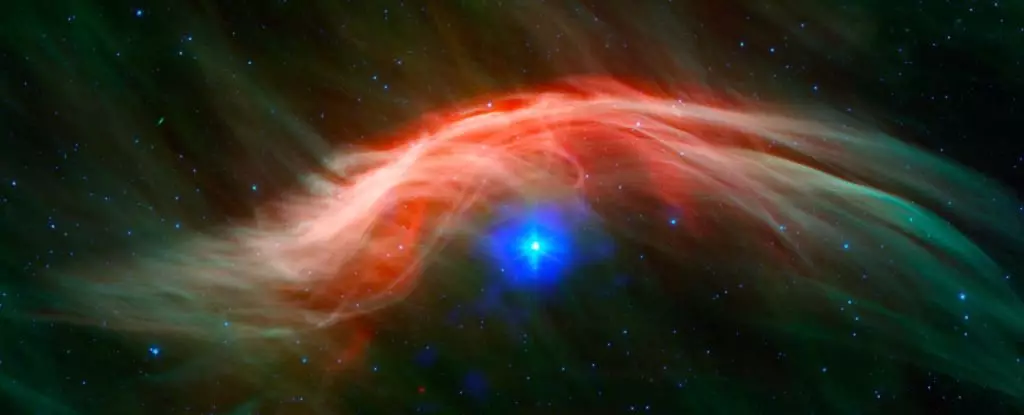The universe operates on vast scales, where stellar events such as supernovae leave indelible marks on the fabric of space and time. Yet, one might wonder: if a star explodes in the quiet expanse of space, does it have any tangible impact on life here on Earth? Recent research suggests a surprisingly intricate relationship between cosmic events and terrestrial evolution, specifically analyzing the implications of a supernova explosion on microbial diversity in Lake Tanganyika, Africa.
Cosmic rays, streams of high-energy particles emitted by supernovae, are thought to influence various biological processes on Earth. Caitlyn Nojiri, an astrophysicist from the University of California Santa Cruz, leads an intriguing study examining how cosmic radiation from an ancient supernova may have spurred a notable diversification of viruses in Lake Tanganyika approximately 2.5 million years ago. The crux of this research revolves around the hypothesis that increased radiation could act as an evolutionary catalyst, potentially leading to genetic mutations and shifts in microbial populations.
While the fundamental mechanism of evolution—natural selection—does not rely on external stimuli like cosmic radiation, it is hypothesized that such radiation can create an environment conducive to genetic variability. This, in turn, may provide the raw material upon which evolutionary pressures act. The study emphasizes that while evolution certainly proceeds independently of these cosmic events, catalysts such as radiation could significantly enhance or expedite these evolutionary processes.
Astronomically speaking, the Solar System is situated within a comparatively tranquil space called the Local Bubble, a region characterized by a relative absence of neighboring stars and, consequently, supernova explosions. Historically, supernova events have shaped this bubble, affecting the radiation levels that Earth experiences. As Nojiri and her collaborators examined the traces of these stellar phenomena, they uncovered compelling evidence linking periods of heightened iron-60—a radioactive isotope produced during supernovae—to specific intervals in Earth’s geological history.
The discovery of iron-60 in sediment cores established two distinct spikes, one dating back between 6.5 to 8.7 million years ago and the more recent one occurring around 1.5 to 3.2 million years ago. The latter spike is particularly relevant, as it aligns with periods of increased cosmic activity. By meticulously modeling cosmic trajectories, Nojiri’s team inferred that the more recent spike corresponded to a supernova event from either the Scorpius-Centaurus association or the Tucana-Horologium star group. This finding not only supports the link between cosmic events and terrestrial changes but also illustrates the complex interplay of forces shaping life on our planet.
What implications does this cosmic radiation have on Earth’s biological systems? The research delves into various models that predict the potential biological effects of radiation exposure resulting from these cosmic events. The findings suggest that if the supernova were from the Scorpius-Centaurus group, Earth might have experienced increasing doses of radiation for as long as 100,000 years post-explosion—doses substantial enough to influence biological survival and mutation processes.
Research indicates that the threshold for causing DNA damage might be as low as 5 milligrays per year. Given the estimated radiation levels proposed by the models, the evolutionary landscape might have been profoundly altered during this time. Moreover, the contemporaneous rise in viral diversity within Lake Tanganyika hints at an exciting possibility: the radiation could have acted as a hidden driver of biological diversity, fostering a more competitive and variable environment for microbial life.
While Nojiri is careful to assert that direct causation remains tenuous, the correlation between cosmic radiation events and the diversification of viruses cannot be overlooked. The timing aligns intriguingly, hinting at a potential interplay between cosmic dynamics and biological evolution. This connection raises questions about the broader implications for understanding life’s trajectory on Earth.
The interplay of cosmic phenomena and life forms invites a renewed appreciation for our existence within the universe. As we contemplate our place in the cosmos, it becomes evident that cosmic events exert influence beyond their immediate surroundings. In the grand tapestry of existence, everything is interconnected, echoing the sentiment expressed by Carl Sagan: we are indeed “stardust.” This understanding not only fosters a sense of wonder about the universe but also encourages us to explore and appreciate the myriad ways in which celestial events shape the world we inhabit.
The study of cosmic phenomena and their biological implications is a testament to the intricate relationships that define our universe. Conducting further research in this domain will not only illuminate the evolutionary processes on Earth but also promote a deeper understanding of the broader cosmic forces at play in the development of life as we know it.


Leave a Reply